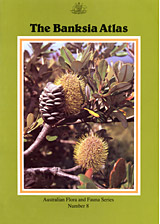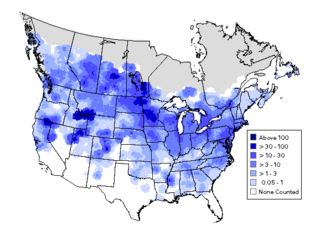
The paradise parrot, Psephotellus pulcherrimus, was a colourful medium-sized parrot native to the grassy woodlands extending across the Queensland and New South Wales border area of eastern Australia. Once moderately common within its fairly restricted range, the last live bird was seen in 1927. Extensive and sustained searches in the years since then have failed to produce any reliable evidence of it, and it is the only Australian parrot recorded as disappearing and presumed extinct.

The British Trust for Ornithology (BTO) is an organisation founded in 1932 for the study of birds in the British Isles. The Duke of Cambridge has been patron since October 2020.

The Royal Australasian Ornithologists Union (RAOU), now part of BirdLife Australia, was Australia's largest non-government, non-profit, bird conservation organisation. It was founded in 1901 to promote the study and conservation of the native bird species of Australia and adjacent regions, making it Australia's oldest national birding association. In 1996, the organisation adopted the trading name of Birds Australia for most public purposes, while retaining its original name for legal purposes and as the publisher of its journal, the Emu. In 2012, the RAOU merged with Bird Observation & Conservation Australia to form BirdLife Australia.

Psephotellus is a genus of medium sized Australian parrots. Four species found across the country are recognised, one is presumed to have become extinct.
The Australian Bird Count (ABC) was a project of the Royal Australasian Ornithologists Union (RAOU). Following the first and successful Atlas of Australian Birds project, which led to the publication of a book on the distribution of Australian birds in 1984, it was suggested by Ken Rogers that the RAOU should next look at bird migration and other movements in Australia. Methodology for a suitable project involving volunteers was worked out through experimental fieldwork and a workshop on ‘Monitoring the Populations and Movements of Australian Birds’.

The Banksia Atlas is an atlas that documents the ranges, habitats and growth forms of various species and other subgeneric taxa of Banksia, an iconic Australian wildflower genus. First published in 1988, it was the result of a three-year nationwide program involving over 400 amateur and professional volunteers.

Wingspan was the quarterly membership magazine of the Royal Australasian Ornithologists Union (RAOU). It was first issued in 1991, replacing the RAOU Newsletter. When Birds Australia and Bird Observation and Conservation Australia merged in 2012 to form BirdLife Australia, Wingspan's run ended, and was replaced with Australian Birdlife magazine.
Pauline Neura Reilly OAM FRAOU was an Australian ornithologist and author of children's books.
Wilson Roy Wheeler MBE FRAOU (1905-1988) was an Australian postman and professional ornithologist. He was an active bird bander and was convener of the Altona Survey Group, later part of the Victorian Ornithological Research Group. In 1965 he was awarded the Australian Natural History Medallion. He was a member of the Royal Australasian Ornithologists Union (RAOU), President 1964–1965, and made a Fellow of the RAOU in 1971.
William Bert Emison (1939–1999) was born in Boise, Idaho, studied zoology at the University of Montana, worked in the Antarctic studying the diet of the Adelie penguin, and received an MSc degree through Johns Hopkins University in 1967. Subsequently, he worked in the Aleutian Islands and studied the whistling swan before moving to Australia in 1972.
John Michael Cullen was an Australian ornithologist, of English origin. Mike Cullen began his academic career by studying mathematics at Wadham College, Oxford, but later switched to zoology, spending time at the Edward Grey Institute of Field Ornithology while investigating the ecology of marsh tits. He subsequently achieved his PhD with Niko Tinbergen with a study of the behaviour of the common tern on the Farne Islands off the coast of Northumberland.

Vincent Noel Serventy AM was an Australian author, ornithologist and conservationist.

The star finch is a seed-eating bird species found in northern Australia. It has a distinctive red face and bill, and broad white spots down its flanks. One of its three subspecies may be extinct.

The EBCC Atlas of European Breeding Birds - their distribution and abundance (ISBN 0-85661-091-7) is an ornithological atlas published for the European Bird Census Council by T & A D Poyser in 1997. Its editors were Ward J. M. Hagemeijer and Michael J. Blair. The atlas was the first to present grid-square distribution maps for all breeding birds at a Europe-wide level. The bulk of the book is in English, although it also contains introductions in thirteen other European languages. The atlas presents the results of the European Bird Census Council's European Ornithological Atlas project, the fieldwork for which was carried out between 1985 and 1988.

The western yellow robin is a species of bird in the Australasian robin family, Petroicidae, native to Australia. Described by John Gould in 1838, the western yellow robin and its Australian relatives are not closely related to either the European or American robins, but they appear to be an early offshoot of the Passerida group of songbirds. Ranging between 13.5 and 15.5 cm long, it has grey upperparts, and a grey breast and head, broken by whitish streaks near the bill and below the eye, with a conspicuous yellow belly. The sexes are similar in appearance. Two subspecies are recognized: subspecies griseogularis, which has a yellow rump, and subspecies rosinae with an olive-green rump.

The pictorella mannikin, pictorella munia, or pictorella finch is small brown and grey finch with a grey bill and distinctive scaly white breast plate which is endemic to northern Australia. It is a seed-eater found in pairs and small flocks in dry savannah and subtropical or tropical dry lowland grassland.

A bird atlas is an ornithological work that attempts to provide information on the distribution, abundance, long-term change as well as seasonal patterns of bird occurrence and make extensive use of maps. They often involve a large numbers of volunteers to cover a wide geographic area and the methods used are standardized so that the studies can be continued in the future and the results remain comparable. In some cases the species covered may be restricted to those that breed or are resident. Migration atlases on the other hand cover migratory birds depict maps showing summaries of ringing and recoveries.

The Atlas of Victorian Birds is a bird atlas, published in 1987, covering the distribution of birds in the Australian state of Victoria. It is based largely on 615,000 field records of birds in Victoria from the Atlas of Australian Birds database, gathered by volunteers in the course of the Royal Australasian Ornithologists Union’s atlas project from 1977 to 1981, as well as an additional 65,000 records gathered by officers of the National Parks and Wildlife Service of Victoria from 1973 to 1986.

The black-backed bittern, also known as the black-backed least bittern or Australian little bittern, is a little-known species of heron in the family Ardeidae found in Australia and vagrant to southern New Guinea. Formerly lumped with the little bittern, it is one of the smallest herons in the world.

BirdLife Australia is the trading name of a company limited by guarantee formed through the merger of two Australian non-government conservation organisations, Bird Observation and Conservation Australia (BOCA) and Birds Australia. A constitution was drafted in May 2011 for BirdLife Australia, which became operational on 1 January 2012. Their respective magazines, the Bird Observer and Wingspan, were succeeded by Australian Birdlife.















